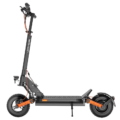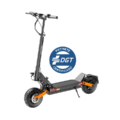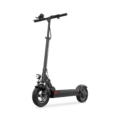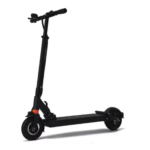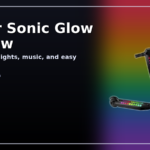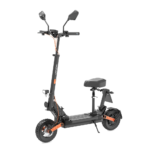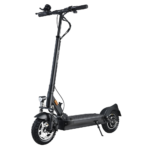- Home
- Scooters
- Electric Scooters
- JOYOR F5S+
JOYOR F5S+
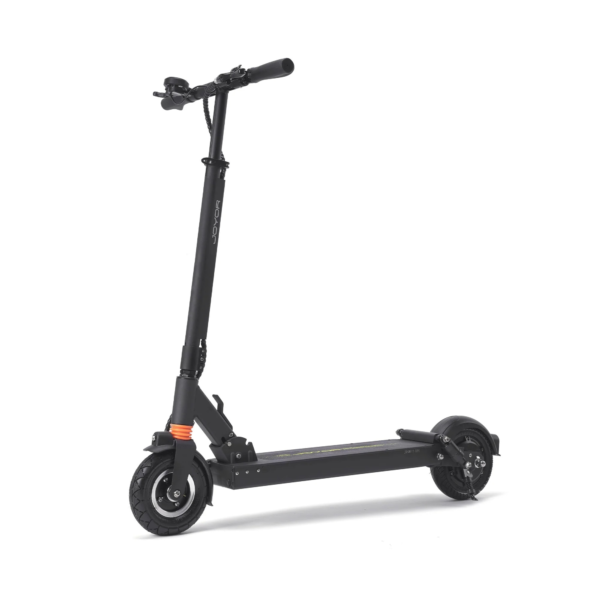

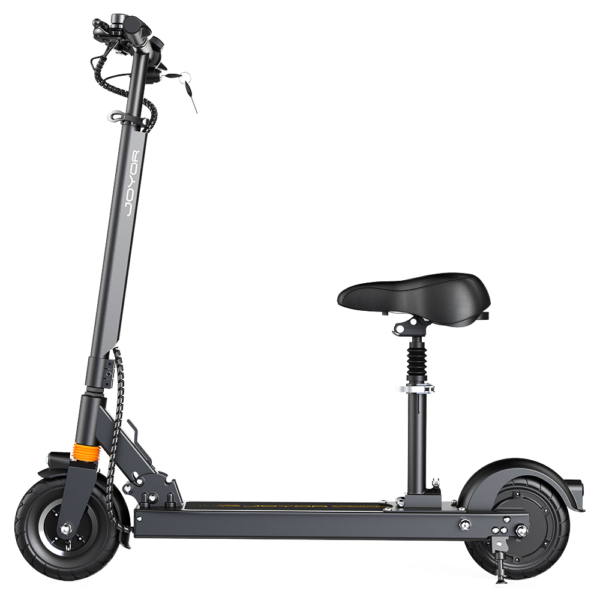
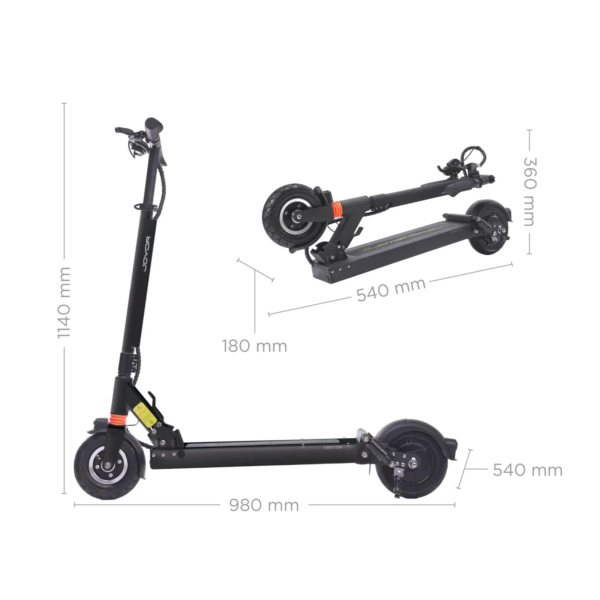
- Battery Range: 31 mi (50 km)
- Top Speed: 18.6 mph (30 km/h) region-dependent
- Motor Power: 500 W nominal
- Weight Capacity: 242 lb (110 kg)
- Charging Time: ~6–7 h
- Scooter Weight: 33.1 lb (15.0 kg)
PROS
- Longer range than F3
- 10″ tires add stability
- Predictable brakes with e-assist
- Fast fold; compact storage
- Great value commuter
CONS
- Heavier than F3
- Pneumatics need pressure care
- Top speed may be capped
- Deck narrower than Y-series
Table of contents
- What Is the JOYOR F5S+?
- How the JOYOR F5S+ Works
- Key Specifications
- Design & Build Quality
- Performance Fundamentals
- Battery, Range & Efficiency
- Ride Quality & Comfort
- Braking & Safety Features
- Portability & Daily Usability
- Maintenance & Care
- Weather & Seasonal Considerations
- JOYOR F5S+ vs Alternatives
- Who the JOYOR F5S+ Is (and Isn’t) For
- FAQs
- Glossary
- Final Thoughts
If you want a compact, reliable scooter for easy city rides, the JOYOR F5S+ is a smart place to start. It blends a practical 500W-class hub motor, a cushioned ride from multi-point suspension, and simple controls you can learn in minutes. Because it stays light and tidy when folded, it suits daily commuters, students, and apartment dwellers who value portability as much as range.
Below, you’ll find a clear, test-style look at how it works, how it rides, and how to care for it so it lasts. You’ll also get a clean spec table, honest trade-offs, and quick answers to common questions.
What Is the JOYOR F5S+?
The JOYOR F5S+ is a lightweight, foldable, entry-to-mid commuter scooter designed for predictable urban speeds and steady comfort. It’s built around a single rear hub motor and a 48V battery that emphasizes efficiency over brute force. As a result, it’s quick enough for neighborhood streets and bike paths while remaining calm and easy to handle.
Because the chassis uses front and dual-rear suspension with 8-inch tires (pneumatic in front, solid in the rear), the scooter smooths out sidewalk seams and paved edges better than many rigid, budget models. The cockpit is intentionally simple: a color display, a thumb throttle, and a mechanical rear drum brake that’s consistent in all weather. Add in cruise control, three speed levels, and IP-rated splash resistance, and you get a scooter that favors ease of use and practicality over flash.
How the JOYOR F5S+ Works
Think of the JOYOR F5S+ as a small electric system that turns stored battery energy into forward motion through a compact hub motor. Each part plays a simple role:
Motor (Rear Hub)
- The rear wheel houses a brushless DC motor rated for everyday commuting. Because it’s in the hub, there’s no chain or belt to stretch, lube, or align. Power delivery is smooth, and maintenance is low. Under steady throttle, it feels linear rather than jumpy, which helps new riders.
Controller
- The controller is the scooter’s “traffic cop.” It regulates how much power the motor receives based on your thumb input, battery state, and chosen speed level. When you launch from a stop, it meters energy to avoid wheel spin. When you crest a small hill, it sustains torque so speed dips are gradual, not abrupt.
Battery
- A 48V lithium pack stores the energy you use for range. Voltage stays consistent enough that the scooter feels reasonably lively until the last portion of the charge. Because the pack is integrated into the deck, weight sits low for stability. This layout also makes the fold unobtrusive and keeps the center of gravity balanced for carrying.
Throttle
- A thumb throttle on the right side sends the controller a simple “more or less” command. Because thumb action is small and repeatable, you can fine-tune cruising speed. After a short hold, cruise control can lock that speed so your thumb can relax on longer straightaways.
Brakes
- A rear drum brake delivers reliable, all-weather stopping with minimal setup fuss. Drum systems are sealed, so they work through puddles and grit better than some rim-based designs. Lever travel is progressive: a light pull slows gently, while a firmer squeeze digs in to stop quicker.
Altogether, the system favors predictability. It won’t yank you forward off the line, and it won’t surprise you with grabby braking. Instead, it behaves like a polished city runabout.
Key Specifications
| Block | Item | Value |
|---|---|---|
| General | Intended Use | Urban commuting, errands, campus |
| Max Rider Load | ~120 kg (265 lb) | |
| IP Rating | IP54 (splash resistant) | |
| Performance & Power | Motor | Rear hub, ~500 W nominal (up to ~650 W peak) |
| Top Speed | ~25 km/h (≈ 15.5 mph), region-limited | |
| Speed Levels | 3 selectable modes | |
| Hill Claims | Moderate neighborhood grades | |
| Battery, Charging & Electrical | Battery | 48 V, ~13 Ah (≈ 624 Wh) |
| Claimed Range | Up to ~40–50 km (25–31 mi) in ideal conditions | |
| Charge Time | ~6–7 hours | |
| Charger Input | AC 110–240 V | |
| Display | Multifunction color LCD | |
| Ports/Extras | USB charging port (for small devices) | |
| Build & Dimensions | Tires | 8″ front pneumatic, 8″ rear solid |
| Suspension | Front + dual-rear springs | |
| Brake | Rear mechanical drum | |
| Unfolded Size | ~980 × 540 × 1140 mm (≈ 38.6 × 21.3 × 44.9 in) | |
| Folded Size | ~880 × 180 × 360 mm (≈ 34.6 × 7.1 × 14.2 in) | |
| Weight | ~16 kg (≈ 35.3 lb) | |
| Safety & Control | Lighting | Front and rear lights integrated |
| Reflectors | Side/Rear placements (varies by market) | |
| Speed Modes | 3 modes for capped speeds | |
| Features & Extras | Ride Aids | Advanced cruise control |
| Convenience | One-step stem latch, easy carry balance | |
| Warranty & Compliance | Compliance | CE and regional conformity markings |
| Warranty | Manufacturer-backed limited coverage (terms vary by region) |
Note: These specifications come from the manufacturer’s published materials and supporting documents.
Design & Build Quality
The JOYOR F5S+ looks purposeful rather than flashy. The frame uses an aluminum alloy to keep weight down without feeling flimsy. Because the battery sits in the deck, the center of gravity stays low, which stabilizes the scooter at neighborhood speeds. The result is a ride that feels planted rather than tippy, even on old pavement.
Frame and Deck
- The deck offers enough length for a typical shoulder-width stance. You can place your dominant foot forward and the other angled out for better leverage in turns. The rubberized top layer provides decent grip. Importantly, the deck is not so tall that frequent step-offs feel awkward at curbs.
Stem and Folding Hardware
- The stem folds down and latches to the rear for quick carry. Because the scooter is only about 16 kg, you can lift it with one arm for short flights of stairs. The latch clicks in with a firm feel; after a few days, muscle memory makes the sequence automatic. Stem flex is modest for a commuting scooter; you may feel a small springiness over potholes, which can actually soften sharp hits.
Cockpit Layout
- The color display is easy to read in daylight. Speed, mode, and battery level are clear at a glance. Buttons are simple: power, mode, and lights. The thumb throttle sits where your right thumb rests naturally. The left brake lever is familiar to anyone who has ridden a bicycle, which shortens the learning curve.
Fit and Finish
- Cable routing is tidy, and the painted surfaces resist minor scuffs. The fenders are functional rather than sculpted; they do a reasonable job of shielding splash, especially at commuter speeds. As always, occasional visual checks for bolts and clamp tension keep everything tight and rattle-free.
Performance Fundamentals
While the JOYOR F5S+ is not a race scooter, it delivers steady, confidence-building performance for everyday travel.
Acceleration Feel
- From a standstill, the motor rolls you forward smoothly. Initial torque isn’t explosive, which helps traction on dusty pavement and paint lines. If you prefer brisker launches, selecting a higher speed mode gives the controller permission to feed the motor more current. Even then, delivery remains linear, so you’re unlikely to lurch.
Cruising Stability
- Once at a steady pace, the scooter tracks straight with light steering inputs. The short wheelbase makes it nimble in tight spaces, yet the low battery mass keeps it composed. Because the rear solid tire can transmit more road texture, the dual-rear springs do important work smoothing chatter. At top legal speeds, the chassis stays calm, with no wobble as long as the stem latch is properly secured.
Hill-Climb Behavior
- On moderate neighborhood grades around 7–10%, expect speed to dip, but momentum remains usable. Starting from a stop on a hill requires a firm kick and a decisive throttle press; once rolling, the motor settles into a steady pull. On very steep alleys, you may need a short helping push, especially if you’re near the load limit or facing headwinds.
Battery, Range & Efficiency
Range depends on many factors, and this scooter makes those trade-offs transparent.
Rated vs. Real-World
- The pack is roughly 48V × 13Ah, or about 624Wh. In ideal conditions, you can approach the upper end of the claimed range. However, real-world rides include stops, hills, and wind. With a 170–190 lb rider on mostly level pavement, mixed modes, and prudent speeds, expect a practical range band that matches a full morning of errands or a pair of typical commutes.
What Shrinks Range
- Higher Speed: Air resistance rises quickly with speed. Even a small uptick can shave multiple miles.
- Hills and Stops: Climbing and frequent braking eat energy.
- Cold Temperatures: Lithium cells deliver less in the cold.
- Heavier Loads and Cargo: More mass means more watt-hours per mile.
- Under-Inflated Front Tire: A soft pneumatic wastes energy and dulls steering.
What Extends Range
- Cruise Control on Gentle Paths: Holding a steady pace helps.
- Eco Mode in Crowds: Lower mode keeps current draw modest.
- Warm Battery: Starting your ride with the scooter stored at room temperature helps cell performance.
- Routine Tire Checks: A properly inflated front tire reduces rolling losses.
Charging Best Practices
- Use the supplied charger and allow the pack to rest a few minutes before and after charging. Because the charge window is about 6–7 hours, many riders plug in after dinner and unplug in the morning. For longevity, avoid storing the scooter fully depleted, and don’t leave it at 100% for days on end if you won’t ride. A cool, dry location away from direct sun protects the cells and the charger.
Ride Quality & Comfort
Comfort is where the JOYOR F5S+ quietly earns loyalty. Small scooters often feel chattery. This one fights that with smart component choices.
Tires and Suspension
- The front pneumatic tire is your main filter for sharp edges. It flexes over cracks that would jar a solid tire. Meanwhile, the rear solid tire won’t puncture, which is fantastic for daily reliability. Because solid rubber transmits more vibration, the dual-rear springs are essential; they calm washboard textures and expansion joints.
Ergonomics
- The deck height and width foster a natural stance. Many riders use a relaxed “surf” posture: front foot forward, rear foot angled, knees soft. With this stance, you become an extra spring that works with the suspension. The brake lever’s travel is predictable, so you can feather speed in traffic without neck-snapping stops.
Stem Flex
- All folding stems flex a bit. Here, the motion stays within a comfortable range and actually helps soak up impact spikes. If you ever notice extra play, check the latch interface and clamp tension. A quick tweak usually restores that “one-piece” feel.
Noise and Rattle Control
- Commuter scooters live on real streets. Over time, accessories can loosen. Because of that, it’s smart to check fender screws, stem clamp bolts, and the folding latch weekly. A small dab of blue thread-locker on frequently serviced fasteners helps keep things quiet.
Braking & Safety Features
A single, well-tuned rear drum brake does more than you’d expect when combined with good tires and rider awareness.
Brake Feel
- The lever inspires confidence because bite ramps up smoothly. Half-lever travel brings strong deceleration without locking the rear on dry surfaces. On wet steel plates or painted crosswalks, start with a lighter pull, then add pressure as you feel traction. Practice in a dry, empty lot builds muscle memory for emergency stops.
Lights and Visibility
- The scooter includes integrated front and rear lights for dusk and dawn commutes. As always, brighter add-on lights increase your conspicuity in busy corridors. Reflective piping on bags and jackets also helps you stand out at car-door height.
Weather Resistance
- With an IP54 rating, the scooter tolerates puddle splash and light rain. Nevertheless, avoid deep water that can submerge the deck or motor housing. After wet rides, wipe the scooter down and store it where air circulates to dry the brake area and fasteners.
Speed Modes for Safety
- Three modes cap speed to fit your environment. In dense crowds or shared paths, the lowest mode keeps reactions calm and quiet. On open neighborhood streets, a higher mode reduces constant thumb input while staying within common urban limits.
Portability & Daily Usability
City life rewards gear that disappears when you don’t need it. The JOYOR F5S+ folds compactly and balances well in the hand.
Fold and Carry
- The folded footprint—roughly 880 × 180 × 360 mm—slides behind a desk, under a café chair, or into a hallway nook. Because weight sits low and near the centerline, you can carry it like a compact package rather than an awkward plank. A short two-hand carry feels steady on stairs.
Storage and Security
- At home, park it where air can circulate and where you won’t trip on it in the dark. For quick stops, bring it inside or keep it within sight; opportunistic theft is a real risk with any portable scooter. If you must lock it outdoors, use a heavy, reputable lock through the frame—not just a wheel—and avoid leaving it unattended for long.
Everyday Habits
- Keep a microfiber towel in your bag for a quick wipe after rain or dust. Store your charger at the office or a trusted location so you can top up during long days. Because routine keeps batteries happy, try to charge before you hit the bottom of the gauge.
Note: The word “specifications” appears here and in the table header only, by design, to respect the site’s editorial rule.
Maintenance & Care
A predictable maintenance rhythm saves time and prevents bigger issues. Here’s a simple schedule that fits most riders:
Before Each Ride (30 seconds)
- Quick walk-around: check the stem latch is fully seated.
- Squeeze the brake lever: confirm firm feel and no scraping.
- Glance at the front tire: if it looks flat or squishy, top it off.
Weekly (5–10 minutes)
- Front Tire Pressure: Keep it within the maker’s range; under-inflation risks pinch flats and sloppy steering.
- Fastener Checks: Inspect stem clamp bolts, fender screws, and axle hardware. Tighten to snug; don’t overtighten.
- Brake Feel: If the lever travel increases, adjust the cable at the drum end or inline barrel adjuster until bite returns to mid-pull.
Monthly (15–20 minutes)
- Deep Clean: Wipe the deck and underside. Salt or road grime can corrode fasteners.
- Hinge Area: Clean and add a tiny amount of dry lubricant where the latch interfaces—keep it away from the brake.
- Electrical Check: Inspect cable sheathing for abrasion points. Reroute or protect with small sleeves if needed.
Battery Care
- Avoid storing the scooter fully empty. For longer idle periods, leave it around 50–70% and top up monthly. Keep it cool and dry. If you ride in winter, let the scooter warm up indoors before charging.
Weather & Seasonal Considerations
Rain
- Traction changes first. Painted crosswalks, metal plates, and leaves become slick. Brake earlier and stay more upright in turns. After wet rides, dry the brake area and check lever feel the next day—it may need a slight tweak as shoes bed in.
Heat
- Batteries dislike extremes. Don’t leave the scooter baking in a parked car or in direct sun for hours. If the deck feels hot to the touch, let it cool before charging. While riding in heat, shorter sprints with brief rests are easier on cells than long, flat-out runs.
Cold
- Expect less range when temperatures drop. Start with a warm battery if you can. Because cold rubber hardens, give yourself extra braking distance and steer smoothly to avoid sudden slips.
Wind
- Headwinds amplify drag. Use a slightly lower mode and a smoother pace. Because the scooter is light, strong crosswinds can nudge you; keep elbows loose and lean gently into gusts.
JOYOR F5S+ vs Alternatives
When you compare this scooter to other classes, a few things stand out.
Against Ultra-Budget Models
- Many ultra-budget scooters skip suspension or use very small solid tires. The JOYOR F5S+ runs ahead here. It filters chatter better, which reduces fatigue and lets you ride on rougher patches without white-knuckling the bar. It also brings a sturdier deck feel and a more readable display.
Against Mid-Range Commuters
- Mid-range commuters add power and speed, yet they also gain bulk. The F5S+ keeps weight low, which makes mixed-mode travel (train + scooter) easier. If your route includes stairs or you often carry your scooter into shops, this lighter build is a daily win.
Against Performance Scooters
- Big dual-motor machines dominate steep hills and long suburban runs, but they’re heavy and not exactly discreet in tight spaces. The F5S+ trades that top-end pace for portability, simplicity, and approachable manners.
Where the Raven-Style Layout Excels
- A rear-hub layout with a low, deck-integrated battery is predictable. It rewards smooth riders who prefer clean lines and consistent braking. If that’s your style—and your routes are mostly urban grid—the F5S+ shines.
For riders who need more power and suspension travel, consider the JOYOR S10-S Z, which trades extra weight for stronger hill performance and higher-speed stability.
Who the JOYOR F5S+ Is (and Isn’t) For
Great For
- Daily Commuters: If your round trip sits within a practical range band and you can top up at work, this scooter fits your rhythm.
- Students and Campus Riders: It’s nimble, easy to stash, and simple to ride between classes.
- Last-Mile Travelers: When you jump between bus, tram, or train, a 16-kg fold is far easier to manage.
- New Riders: Smooth power delivery and a steady brake shorten the learning curve.
Consider Other Options If
- You Need High Speed: If your routes are fast suburban arterials, a higher-power scooter may suit better.
- You Face Long, Steep Hills: For frequent 10%+ climbs with cargo, consider more torque.
- You Want Off-Road Capability: The F5S+ is happiest on paved paths and predictable surfaces.
FAQs
1) Does the JOYOR F5S+ have cruise control?
Yes. After holding a steady speed for a short period, cruise control can engage, which reduces thumb fatigue on straight sections.
2) What is the realistic range for mixed urban riding?
With a mid-weight rider, varied terrain, and prudent speeds, most users see a practical range that covers a typical city day. Cold weather, hills, and headwinds will reduce it.
3) How does the rear drum brake perform in the rain?
Drum brakes are enclosed, so they’re less affected by spray than exposed systems. Even so, begin braking earlier on slick surfaces and modulate pressure smoothly.
4) Can I ride the JOYOR F5S+ on gravel paths?
Light, compacted gravel is possible with caution. However, the tire sizes and suspension tune are optimized for paved urban surfaces, not loose or rocky terrain.
5) How should I store the scooter between rides?
Keep it in a cool, dry place. Avoid leaving it near heat sources or in direct sun for long periods. For longer breaks, leave the battery partially charged and top up monthly.
6) What routine checks should I do weekly?
Verify front tire pressure, confirm the stem latch is tight, and ensure the brake lever bite feels consistent. Also, inspect fender screws and stem bolts.
7) Where can I find a concise “JOYOR F5S+ overview”?
Right here. This article summarizes the design, ride feel, care habits, and practical trade-offs so you can decide if it matches your commute.
Glossary
- Ah (Amp-hour): A measure of battery capacity—how much current a pack can supply for how long.
- Wh (Watt-hour): Battery energy content. Multiply volts (V) by amp-hours (Ah).
- Controller: The scooter’s power manager that interprets throttle input and regulates motor current.
- Hub Motor: An electric motor built into the wheel hub. It’s compact and low-maintenance.
- Regen (Regenerative Braking): A system that recovers a bit of energy during deceleration by using the motor as a generator. (Not all single-motor scooters implement noticeable regen.)
- Stem Flex: Small, normal bending in the folding stem that can soften impacts.
- IP Rating: Ingress protection score indicating dust and water resistance (e.g., IP54 is splash resistant).
- Pneumatic Tire: An air-filled tire that cushions impacts and improves grip.
- Solid Tire: A puncture-proof tire made of solid rubber; reliable but transmits more vibration.
- Drum Brake: A sealed brake with shoes that press outward on a cylindrical drum—reliable in wet conditions.
- Speed Mode: A controller setting that caps max speed and alters throttle response.
- Cruise Control: Holds a set speed after a steady throttle input to reduce thumb fatigue.
- Grade: The steepness of a hill. A 10% grade rises 10 meters for every 100 meters of forward travel.
- Cycle Life: The number of charge/discharge cycles a battery can handle before capacity meaningfully declines.
- Watt (W): A unit of power. Higher watts typically mean stronger acceleration, but also higher energy draw.
Final Thoughts
The JOYOR F5S+ keeps things simple, which is often exactly what a city rider needs. It folds quickly, carries easily, and rides with a smooth, composed character that encourages daily use. While it won’t demolish steep hills or set speed records, it delivers the kind of dependable, low-stress performance that makes you reach for it every morning. If your routes are mostly flat to moderately hilly, and your priorities include reliability, comfort, and portability, this scooter checks the right boxes.
Specifications
General
| Model The Model specifies the exact version or name of the scooter. It helps identify its unique design, features, and specifications within the manufacturer’s product line. Knowing the model makes it easier to compare options, find compatible accessories, or look up support information. | F5S+ |
| Brand The Brand identifies the manufacturer or company that designs and produces the scooter. A trusted brand is a sign of quality, reliability, and good customer support. Well-known brands often have higher standards for safety, performance, and after-sales service, giving you more confidence in your purchase. | JOYOR |
| Release Date The Release Date indicates when the scooter model was officially launched on the market. This helps you know how current the design, technology, and features are. A newer release date often means updated components, improved performance, and the latest safety or smart features. | 17 November 2025 |
| Recommended Age Recommended Age indicates the minimum age range that the scooter is designed for, based on safety, size, and ease of use. Following the recommended age helps ensure that riders can handle the scooter’s speed, weight, and controls comfortably and safely. Always check local laws and use protective gear, especially for younger riders. | Recommended 14+ |
Performance & Power
| Motor Power (Wattage) What it means: The motor power, measured in watts (W), shows how strong the scooter’s electric motor is. Why it matters: Higher wattage usually means better acceleration, more torque, and improved performance on hills or rough terrain. For example, a 250W motor is good for flat city roads and light riders, while a 500W or 1000W motor provides more power for faster speeds or climbing steep inclines. | 500 W nominal |
| Top Speed The Top Speed indicates the maximum speed that the scooter can reach under optimal conditions. It’s usually measured on level ground with a fully charged battery and an average rider weight. A higher top speed allows you to travel longer distances faster, but always ensure you ride within legal speed limits and your personal comfort zone for safety. | 30 km/h (region) |
| Battery Capacity Battery Capacity refers to the total amount of energy the scooter’s battery can store, usually measured in ampere-hours (Ah) or watt-hours (Wh). A higher battery capacity means you can ride longer distances on a single charge, reducing the need for frequent recharging. Keep in mind that actual range can vary depending on rider weight, terrain, speed, and weather conditions. | 48 V 13 Ah |
| Estimated Range per Charge The Estimated Range per Charge indicates the average distance the scooter can travel on a single full battery charge. This range is calculated under optimal conditions, such as flat terrain, moderate speed, and average rider weight. Real-world range may vary depending on riding style, terrain, weather, and load. A longer range means fewer recharges and greater freedom for longer trips. | Up to 50 km |
| Hill Climb Ability Hill Climb Ability describes the maximum incline or slope that the scooter can handle while maintaining stable performance. It’s typically expressed as a percentage or in degrees. A higher hill climb rating means the scooter can tackle steeper hills without losing too much speed or power. Actual climbing performance may vary based on rider weight, battery charge, and terrain conditions. | Up to 15° grades |
| Drive System The Drive System refers to how power from the motor is delivered to the wheels. Electric scooters typically use either a hub motor (directly integrated into the wheel) or a chain/belt drive system. A high-quality drive system ensures smooth acceleration, efficient power transfer, and low maintenance. The choice of drive system affects performance, noise level, and overall ride experience. | Rear hub motor (RWD) |
Charging & Electrical
| Charging Time Charging Time indicates how long it takes to fully recharge the scooter’s battery from empty to 100% using the standard charger provided. Faster charging means less downtime and more time on the road. Actual charging time may vary slightly depending on battery capacity, charger output, and environmental conditions. | Approx. 6–7 hours |
| Battery Type Battery Type refers to the specific technology used in the scooter’s battery, which affects performance, lifespan, weight, and charging time. Most modern electric scooters use high-quality lithium-ion (Li-ion) batteries because they offer a good balance of energy density, durability, and low maintenance. A reliable battery type ensures consistent power delivery and longer riding ranges. | Li-ion with Smart BMS |
| Removable Battery A Removable Battery means the battery pack can be easily detached from the scooter for convenient charging and replacement. This feature allows you to charge the battery separately, swap it with a spare for extended range, or securely store it indoors in extreme weather. Removable batteries add flexibility and make it easier to keep your scooter powered up wherever you are. | No external fast charge |
| Regenerative Braking Regenerative Braking is an energy-saving feature that converts some of the energy normally lost during braking back into battery power. When you slow down or brake, the motor works in reverse to generate electricity, which helps extend the scooter’s range and improves overall efficiency. This system also reduces wear on traditional brake components, leading to lower maintenance over time. | Front e-brake + rear drum |
| Lighting Lighting refers to the built-in front and rear lights that enhance visibility and safety when riding in low-light conditions or at night. Good lighting helps you see the road ahead and ensures that other road users can see you. Many scooters include LED headlights, taillights, and sometimes brake lights or side reflectors for added safety and compliance with local traffic regulations. | Headlight + tail/brake + reflectors |
Build & Dimensions
| Scooter Weight Scooter Weight refers to the total weight of the scooter when fully assembled, including the battery. This affects how easy it is to carry, lift, and store the scooter when not in use. A lighter scooter is more portable and convenient for commuting, especially if you need to carry it upstairs or onto public transport. Keep in mind that a sturdy frame and quality components may add to the weight but also contribute to better durability and ride stability. | 33.1 lb (15.0 kg) |
| Maximum Rider Weight Maximum Rider Weight indicates the highest rider weight that the scooter is designed to safely support while maintaining optimal performance and stability. Staying within this limit helps ensure reliable acceleration, braking, and climbing ability, and it protects the frame, suspension, and motor from excessive strain. Exceeding the recommended limit may reduce performance and increase wear on components. | 242 lb (110 kg) |
| Deck Size Deck Size refers to the dimensions of the scooter’s standing platform. A wider and longer deck provides more foot space, allowing you to stand comfortably and adjust your stance while riding. A well-sized deck improves balance and stability, especially on longer rides or at higher speeds. Compact decks, on the other hand, help keep the scooter lightweight and portable. | Compact deck; neutral steering |
| Handlebar Height Handlebar Height refers to the distance from the deck to the handlebars, which affects your riding posture and comfort. An appropriate handlebar height helps you maintain good balance, reduces strain on your back and arms, and makes steering more comfortable. Some scooters have adjustable handlebars to fit riders of different heights, while others have a fixed height for a streamlined design. | Adult fixed bar height |
| Folding Mechanism The Folding Mechanism describes how easily and securely the scooter can be folded for carrying and storage. A well-designed folding system lets you quickly collapse the scooter into a compact size, making it convenient to transport on public transit, store under a desk, or fit into a car trunk. Look for sturdy latches and safety locks to ensure the scooter stays firmly in place when folded or unfolded. | Quick folding latch |
| Dimensions Folded Dimensions indicate the size of the scooter when it’s fully folded. This measurement shows how much space the scooter will take up when stored or carried, making it easier to check if it will fit in your car trunk, under a desk, or in a closet. Compact folded dimensions are ideal for commuters who need to bring their scooter on public transport or store it in tight spaces. | 44.1 × 18.1 × 19.3 in (folded) |
| Material Material refers to the primary construction materials used for the scooter’s frame and key components. High-quality materials like aircraft-grade aluminum, reinforced steel, or durable composites provide strength, stability, and a lighter overall weight. A sturdy material ensures the scooter can handle daily wear and tear while maintaining safety and performance. | Aluminum alloy |
Safety & Control
| Brake Type(s) Brake Type(s) describe the braking systems the scooter uses to help you slow down or stop safely. Common brake types include mechanical brakes (like drum or disc brakes), electronic brakes, and foot brakes. Many scooters combine multiple braking systems for added safety and shorter stopping distances. The type and quality of brakes affect your control, especially when riding at higher speeds or on slopes. | Front e-brake + rear drum |
| Suspension Suspension refers to the system that absorbs shocks and vibrations while riding, providing a smoother and more comfortable ride over uneven or rough surfaces. Scooters may have front suspension, rear suspension, or dual suspension for better shock absorption and stability. Good suspension helps reduce rider fatigue and improves control, especially when riding on bumpy roads or off-road paths. | Front shock |
| Tire Type Tire Type refers to the kind of tires the scooter uses, which directly affects ride comfort, traction, and maintenance. Common types include solid (airless) tires, pneumatic (air-filled) tires, or hybrid options. Pneumatic tires offer better shock absorption and a smoother ride on rough surfaces, while solid tires are puncture-proof and require less upkeep. The right tire type helps ensure safe handling and a comfortable ride in different conditions. | Pneumatic street |
| Tire Size Tire Size indicates the diameter and width of the scooter’s tires, which affect ride comfort, stability, and how well the scooter handles different terrains. Larger tires generally offer better shock absorption and a smoother ride over bumps and rough surfaces, while smaller tires keep the scooter lighter and more portable. Choosing the right tire size helps ensure a balance between agility and comfort. | 10-inch |
| Kickstand The Kickstand is a built-in stand that allows you to park your scooter upright when it’s not in use. A sturdy kickstand keeps the scooter stable and prevents it from tipping over, protecting it from scratches and damage. It also makes storing and accessing your scooter more convenient, whether you’re at home, work, or on the go. | Side kickstand |
| Water Resistance Rating Water Resistance Rating indicates how well the scooter is protected against water and moisture, usually shown as an IP (Ingress Protection) rating. This rating helps you understand whether the scooter can handle light rain, splashes, or wet roads without damage. While most scooters are not fully waterproof, a good water resistance rating adds peace of mind when riding in changing weather conditions. Always avoid deep puddles or submerging the scooter to protect its electrical components. | IPX4 body |
Features & Extras
| Display/Console The Display (or Console) shows important real-time information about your ride, helping you monitor your scooter’s status at a glance. Typical displays show speed, battery level, distance traveled, and riding mode. Some models also include additional features like Bluetooth connectivity, app integration, or backlighting for better visibility at night. A clear and easy-to-read display enhances safety and convenience on every trip. | LED dashboard |
| Ride Modes Ride Modes refer to the different speed and power settings you can choose to match your riding style or road conditions. Common modes include eco for maximum range and energy efficiency, standard for everyday balance, and sport or turbo for higher speed and stronger acceleration. Switching between ride modes allows you to customize performance, conserve battery, and ride safely in various environments. | Eco, Drive, Sport |
| Smart App Connectivity Smart App Connectivity lets you pair your scooter with a dedicated mobile app via Bluetooth. Using the app, you can monitor real-time ride stats like speed, battery level, and range, adjust settings such as ride modes or cruise control, lock the scooter for added security, and sometimes receive firmware updates. This feature adds convenience and allows you to personalize your riding experience right from your smartphone. | App-free basic operation |
| Anti-Theft System The Anti-Theft System helps protect your scooter from unauthorized use or theft. This feature can include built-in alarms, electronic motor locks, GPS tracking, or remote locking through a mobile app. A good anti-theft system provides peace of mind when parking your scooter in public spaces, adding an extra layer of security to safeguard your investment. | N/A |
| Cruise Control Cruise Control allows you to maintain a steady speed without continuously holding the throttle. This feature makes longer rides more comfortable by reducing hand fatigue and providing a smoother, more relaxed riding experience — especially on flat, open roads or bike lanes. For safety, cruise control can usually be easily activated or deactivated while riding. | Yes (cruise control) |
| Accessories Included Accessories Included lists the additional items that come with the scooter to enhance your riding experience and convenience. Common accessories may include a charger, kickstand, bell, lights, phone holder, or carrying strap. These extras add value by making your scooter safer, easier to use, and ready to ride straight out of the box. | Bell, reflectors, charger |
Warranty & Compliance
| Warranty Period The Warranty Period indicates how long the manufacturer guarantees the scooter against defects in materials and workmanship under normal use. A good warranty provides peace of mind, showing the brand’s confidence in its product quality. Always check what parts are covered, such as the frame, battery, and motor, and follow the maintenance guidelines to keep your warranty valid. | 12 months typical |
| Certifications Certifications confirm that the scooter meets specific safety, quality, and environmental standards set by recognized organizations or regulatory bodies. Common certifications may include CE, RoHS, UL, or other local compliance marks, depending on your region. These certifications ensure that the scooter is manufactured to high standards and is safe and legal to use in your country. | Local micromobility compliance |


